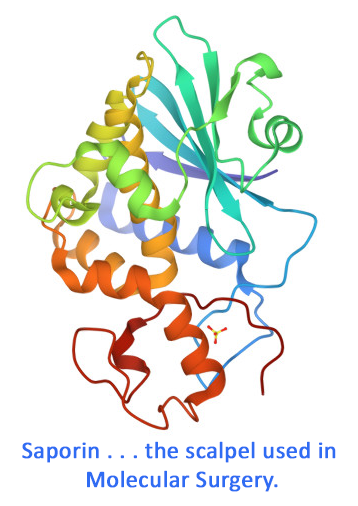Galanin is a 29-amino acid peptide (30 amino acids in humans) implicated in a variety of functions including nociception, appetite, learning, and memory. It is widely distributed throughout the neural and endocrine systems, playing roles in the secretion of insulin, somatostatin, glucagon, dopamine, and growth hormone, and inhibiting the release of acetylcholine and substance P from myenteric neurons. Galanin-SAP eliminates cells expressing the galanin-1 receptor. It is not suitable for retrograde transport.
Galanin-SAP is a chemical conjugate of rat galanin and the ribosome-inactivating protein, saporin. It eliminates cells expressing the galanin-1 receptor.
Galanin-SAP is available individually (Cat. #IT-34) or as a kit (Cat. #KIT-34) which includes Galanin-SAP and Blank-SAP (Cat. #IT-21).
keywords: galanin, galanin-1 receptor, acetylcholine, substance P, SP, saporin, somatostatin-positive interneurons, neurons, globus pallidus, thalamus, learning, memory, eating, appetite, diet, brain, neuroscience, GABA
GABAergic terminals are a source of galanin to modulate cholinergic neuron development in the neonatal forebrain.
Keimpema E, Zheng K, Barde SS, Berghuis P, Dobszay MB, Schnell R, Mulder J, Luiten PG, Xu ZD, Runesson J, Langel U, Lu B, Hokfelt T, Harkany T (2014) GABAergic terminals are a source of galanin to modulate cholinergic neuron development in the neonatal forebrain. Cereb Cortex 24(12):3277-3288. doi: 10.1093/cercor/bht192
Summary: In this work the authors sought to clarify the role of galanin during brain development. Several different techniques were used including the use of Galanin-SAP (Cat. #IT-34) on primary cell cultures from the fetal forebrains of rats. Cultured basal forebrain neurons were exposed to 5 ng/ml of Galanin-SAP for 8 hours, and cell death was assessed after 72 hours. Cholinergic cells were killed by Galanin-SAP, indicating that these neurons can use extracellular galanin-2 receptors to facilitate development.
Related Products: Galanin-SAP (Cat. #IT-34)
Galanin receptor-expressing dorsal horn neurons: role in nociception
Lemons LL, Wiley RG (2011) Galanin receptor-expressing dorsal horn neurons: role in nociception. Neuropeptides 45(6):377-383. doi: 10.1016/j.npep.2011.08.002
Summary: This work examines the mociceptive role of galanin receptor-1-expressing neurons found in the superficial dorsal horn. 500 ng of galanin-SAP (Cat. #IT-34) was injected into the lumbar intrathecal space of rats; blank-SAP (Cat. #IT-21) was used as a control. The rats were then tested in a series of thermal nociception models. Lesioned animals were less sensitive to heat, suggesting that loss of the gal1r-expressing excitatory interneurons disrupted the pain transmission pathway.
Related Products: Galanin-SAP (Cat. #IT-34), Blank-SAP (Cat. #IT-21)
Neuropeptide receptor co-expression in superficial dorsal horn: Effects of galanin-saporin, neuropeptide y-saporin and dermorphin-saporin
Lemons LL, Chatterjee K, Wiley RG (2010) Neuropeptide receptor co-expression in superficial dorsal horn: Effects of galanin-saporin, neuropeptide y-saporin and dermorphin-saporin. Neuroscience 2010 Abstracts 585.5/XX19. Society for Neuroscience, San Diego, CA.
Summary: We have previously shown that the role of specific neurons in behavioral processes can be fruitfully studied using targeted toxins. Toxins composed of a targeting neuropeptide coupled to the ribosomal-inactivating toxin, saporin, are used to selectively destroy superficial dorsal horn neurons expressing the cognate peptide receptors followed by assessment of changes in pain behavior. In the present study, we sought to compare the anatomic effects of three closely related targeted toxins, each with different nocifensive behavioral effects. Rats were given single lumbar intrathecal injections of either galanin-saporin (Gal-SAP), neuropeptide Y-saporin (NPY-SAP), or dermorphin-saporin (Derm-SAP). Lumbar spinal cord sections from each rat were stained for each of the three receptors, GalR-1, Y1R and MOR (mu opiate) using standard immunoperoxidase technique. Each toxin produced a significant decrease in staining for its cognate receptor. Gal-SAP animals showed no change in either MOR or Y1R staining. NPY-SAP rats showed decreased staining for both GalR1 and MOR, and Derm-SAP rats were assessed for changes in expression of GalR1 and Y1R. These findings suggest overlaps between the populations of neurons that express the GalR1, Y1R, and MOR. Specifically, Y1R-expressing neurons also express GalR1 and MOR, probably by separate subpopulations of Y1R neurons. The results also suggest either that Gal-SAP only kills neurons that do not express either of the other two receptors, or some of the observed loss of receptors after NPY-SAP is due to secondary (transsynaptic) effects. Double- and triple-label fluorescent immunohistochemistry will be used to directly visualize receptor co-expression patterns and targeted toxin effects. These results will be valuable in interpreting the unique nocifensive behavioral effects of each of these targeted toxins.
Related Products: Dermorphin-SAP / MOR-SAP (Cat. #IT-12), Galanin-SAP (Cat. #IT-34), NPY-SAP (Cat. #IT-28)
browse all references for this product | back to top


Reviews
There are no reviews yet.